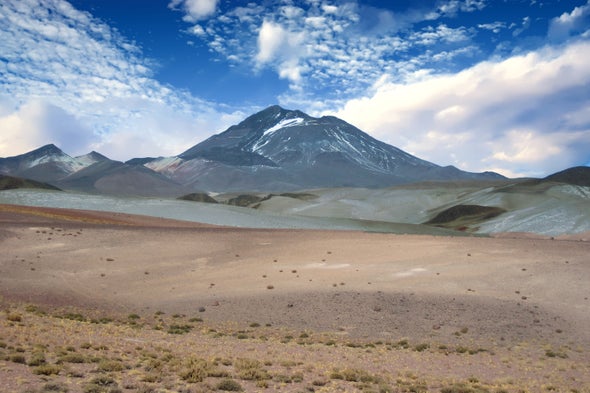(单词翻译:单击)
听力文本
This is Scientific American's 60-second Science, I'm Julia Rosen.
In 2013 two mountaineers were nearing the top of Volcán Llullaillaco, a 22,000-foot-tall volcano on the border of Chile and Argentina—when they saw something unexpected. Just 2,000 feet below the summit, the climbers spotted a mouse scurrying across the snow.
"It's really a remarkable sighting, because no one expected wild mammals to be living at an elevation of over 20,000 feet. At that elevation, the scarcity of oxygen makes it really a challenging place to survive and function. But also, the extreme cold. It's an extremely inhospitable environment."
Jay Storz, an evolutionary biologist at the University of Nebraska. The climbers reached out to Storz because he studies how animals adapt to high altitudes. And he was so intrigued that he decided to make his own trip to survey the area.
Storz and his colleagues spent a month at Llullaillaco earlier this year, where they confirmed what the climbers saw. They found mice everywhere, including on the summit—officially setting a new record for the world's highest-dwelling mammal.
Storz says the summit sighting was fortuitous. His climber partner, Mario Pérez Mamani, saw the mouse dive under a rock just as Storz made it to the top, exhausted and groggy from the thin air. It took Storz a minute to gather his wits, but he eventually managed to catch the mouse with his hands. Storz collected that mouse and others as museum specimens that will enable future scientific analysis.
They also recorded their encounter on video. The report is in the Proceedings of the National Academy of Sciences.

Now that he's home, Storz wants to understand how these mice can survive in such harsh conditions and, conversely, what prevents other animals from venturing so high.
"Clearly, the mice that are living at these extreme altitudes have physiological capacities that are very different from your typical rodent."
He and his colleagues are comparing the genomes of the mice from Llullaillaco to their lowland relatives to see if they can identify the animal's high-altitude adaptations. He's curious whether they have evolved some of the same strategies as mice that live at high elevations in North America and the Himalayas.
Storz also wants to know how mice are finding food on top of a barren, rocky volcano, thousands of feet above the highest green plants. On his next trip, he plans to analyze the stomach contents of the animals they capture.
"It's really an open question whether most species—whether their elevational limit is set by physiological tolerance or just the lack of ecological opportunity. It's probably a combination of both."
Whatever the answer, Storz suspects there may be more high-altitude animals out there than scientists thought. It's just a matter of climbing high enough to find them.
Thanks for listening for Scientific American's 60-second Science, I'm Julia Rosen.
参考译文
这里是科学美国人——60秒科学系列,我是朱莉娅·罗森。
2013年,两名登山者即将登上智利和阿根廷边境上海拔2.2万英尺高的尤耶亚科火山山顶时,看到了意到不到的东西。就在山顶下2000英尺处,登山者发现一只老鼠在雪地里疾驰。
“这真是非凡的目击,因为此前没人想到野生哺乳动物会生活在海拔超过2万英尺的地方。在那个海拔高度,氧气的匮乏使该地的生存和运作极具挑战性。还有极端寒冷。这是极其不适宜居住的环境。”
内布拉斯加大学的进化生物学家杰伊·斯托兹说到。登山者联系了斯托兹,因为他研究动物如何适应高海拔。他对此非常感兴趣,于是决定自己去那个地区进行考察。
今年早些时候,斯托兹及其同事在尤耶亚科山火山待了一个月,他们证实了登山者所看到的情况。他们发现老鼠无处不在,包括山顶上——这正式创下了世界上居住最高的哺乳动物的新纪录。
斯托兹表示,在山顶上看见老鼠是偶然的。他的登山伙伴马里奥·佩雷斯·马马尼在斯托兹成功登顶时看到那只老鼠冲到了岩石下面,当时斯托兹筋疲力尽,因空气稀薄而头晕目眩。斯托兹费了一分钟才恢复意识,但最终还是成功用手抓住了老鼠。斯托兹收集了这只老鼠和其他老鼠作为博物馆标本,以便将来进行科学分析。
他们还用视频记录了他们的遭遇。这项报告发表在《美国国家科学院院刊》上。
现在斯托兹已返回家中,他想了解这些老鼠如何在如此恶劣的条件下生存,反过来说,是什么阻止了其他动物冒险到如此高的地方。
“很明显,生活在这些极端海拔的老鼠,其生理机能与普遍的啮齿动物大不相同。”
他和同事正在比较尤耶亚科火山的老鼠和其低地近亲的基因组,看看是否能确定这种老鼠的高原适应能力。他很好奇它们是否进化出了与生活在北美和喜马拉雅山高海拔地区的老鼠相同的策略。
斯托兹还想知道老鼠如何在一座贫瘠的岩石火山顶寻找食物,其山顶比最高的绿色植物高出数千英尺。他计划在下次旅行中分析他们所捕获动物的胃内容物。
“大多数物种的海拔极限是由其生理耐受性决定,还是仅仅因为缺乏生态机会,这确实是个悬而未决的问题。可能二者兼有。”
无论答案是什么,斯托兹都怀疑那里可能存在比科学家想象的更多的高海拔动物。只要爬到足够高的地方就能发现它们。
谢谢大家收听科学美国人——60秒科学系列,我是朱莉娅·罗森。
译文为可可英语翻译,未经授权请勿转载!
重点讲解
重点讲解:
1. adapt to 适应;
An open-minded person is able to adapt to new conditions.
一个开明的人能够适应新情况。
2. make it (经历艰难困苦后)成功;
I believe I have the talent to make it.
我相信自己有成功的天分。
3. manage to do sth. 设法做到;成功完成;
Somehow, he'd managed to persuade Kay to buy one for him.
不知用了什么方法,他成功说服凯给他买了一个。
4. be different from 有差别的;不同的;
The new methods are radically different from the old.
新的方法迥然不同于旧的方法。
关注微信公众号【可可双语精读】,获取详细讲解内容


